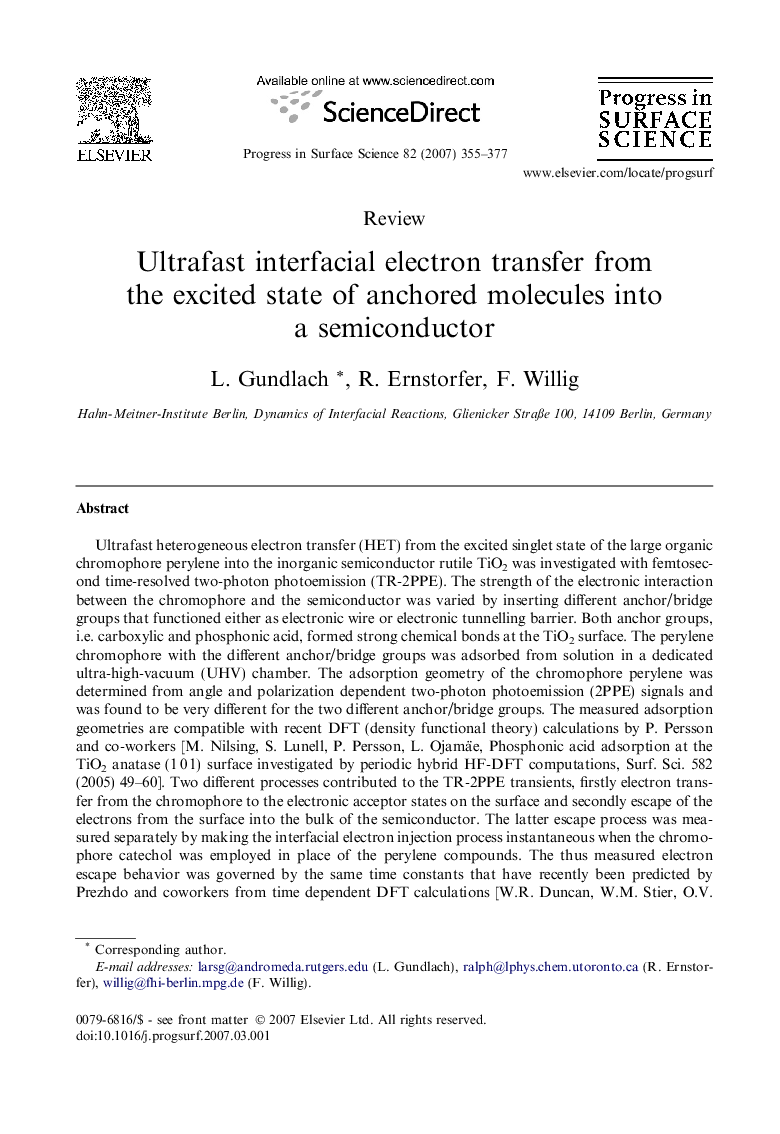| Article ID | Journal | Published Year | Pages | File Type |
|---|---|---|---|---|
| 5420136 | Progress in Surface Science | 2007 | 23 Pages |
Abstract
Ultrafast heterogeneous electron transfer (HET) from the excited singlet state of the large organic chromophore perylene into the inorganic semiconductor rutile TiO2 was investigated with femtosecond time-resolved two-photon photoemission (TR-2PPE). The strength of the electronic interaction between the chromophore and the semiconductor was varied by inserting different anchor/bridge groups that functioned either as electronic wire or electronic tunnelling barrier. Both anchor groups, i.e. carboxylic and phosphonic acid, formed strong chemical bonds at the TiO2 surface. The perylene chromophore with the different anchor/bridge groups was adsorbed from solution in a dedicated ultra-high-vacuum (UHV) chamber. The adsorption geometry of the chromophore perylene was determined from angle and polarization dependent two-photon photoemission (2PPE) signals and was found to be very different for the two different anchor/bridge groups. The measured adsorption geometries are compatible with recent DFT (density functional theory) calculations by P. Persson and co-workers [M. Nilsing, S. Lunell, P. Persson, L. Ojamäe, Phosphonic acid adsorption at the TiO2 anatase (1Â 0Â 1) surface investigated by periodic hybrid HF-DFT computations, Surf. Sci. 582 (2005) 49-60]. Two different processes contributed to the TR-2PPE transients, firstly electron transfer from the chromophore to the electronic acceptor states on the surface and secondly escape of the electrons from the surface into the bulk of the semiconductor. The latter escape process was measured separately by making the interfacial electron injection process instantaneous when the chromophore catechol was employed in place of the perylene compounds. The thus measured electron escape behavior was governed by the same time constants that have recently been predicted by Prezhdo and coworkers from time dependent DFT calculations [W.R. Duncan, W.M. Stier, O.V. Prezhdo, Ab initio nonadiabatic molecular dynamics of the ultrafast electron injection across the Alizarin-TiO2 interface, J. Am. Chem. Soc. 127 (2005) 7941-7951]. The HET times derived from the 2PPE transients showed very good agreement with HET times measured via transient absorption (TA) on anatase TiO2 layers. The measured energy distribution of the 2PPE signals for the injected electrons suggests that a high density of electronic acceptor states is operative in both systems and is spread over an at least 1Â eV wide energy range. The acceptor states are tentatively identified with surface states created through the formation of chemical bonds between the anchor groups of the organic molecules and surface atoms of the semiconductor.
Related Topics
Physical Sciences and Engineering
Chemistry
Physical and Theoretical Chemistry
Authors
L. Gundlach, R. Ernstorfer, F. Willig,
